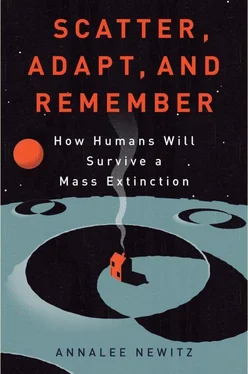Studying these groups and others has given Ostrer a perspective on the results of diaspora, rather than the events leading up to it. One point he emphasized strongly was that diaspora is more often about staying rather than scattering. Jewish history can be characterized by long periods of settlement and assimilation into local cultures, punctuated by sudden shifts when many people abruptly fled to new lands, usually to escape persecution. As geneticist David Goldstein notes in his book Jacob’s Legacy: A Genetic View of Jewish History , some of the earliest historical records of the Jews come from sixth-century BCE cuneiform tablets, which describe the Babylonian conquest of Jerusalem. But the results of that diaspora are lost to history. The next great Jewish settlement took place in Rome, and the diaspora that resulted has genetic echoes all the way up into the twenty-first century. The Roman diaspora is the focus of Ostrer’s research.
There are extensive records of Jewish culture from the Roman empire during the first century CE. Many of these Jews were brought to Rome as slaves starting in the second century BCE, from Greece, Judea (the former southern kingdom of Judah), and many areas in the region. Over the next century, Jews assimilated into Roman culture and became one of the biggest and most powerful minority groups in the empire. Though we have no reliable source for how many Jews there were in Rome, we know from contemporary sources that Judaism was a highly visible religion. Politicians issued laws regulating the practice of Judaism, and many Jews became Roman citizens. Meanwhile, in the courts, commentators often complained of Jewish “disturbances”—probably referring to political unrest in response to constantly shifting Roman rules about Jewish taxation and social status.
Unlike today, Roman Jews expanded the ranks of their temples by actively proselytizing. They assimilated into Roman life, but Romans assimilated into Jewish traditions, too. It was a time of great cultural mixing that finally came to an end in the late first century CE, when Emperor Claudius ordered all Jews to be expelled from Rome. A few years later, some Jews in Jerusalem rebelled against the Roman control of their city and were defeated, while Roman Jews fled their homes to avoid death or worse. In the Bible, this period is referred to as the time of the Second Temple’s destruction because the Romans destroyed the house of worship on the Temple Mount just as the Babylonians had over 600 years before.
Though this diaspora survives in historical documents and biblical stories, Ostrer wanted to know if he could track down evidence of a direct genetic connection between the Jews who left ancient Rome and the Jews alive today. To find out, he had to get DNA samples from hundreds of Jews across the world, looking for genetic commonalities. “I went to Rome and did recruitment there,” Ostrer recalled. “That’s been a stable community for hundreds of years and perhaps dates back to the community that was there in classical antiquity.” He also got samples from Eastern European Jews as well as Jews in immigrant communities in the New York area. Anybody who could trace their Jewish ancestry back two generations to all four of their grandparents was eligible to participate.
Once he’d amassed his samples, Ostrer and his team had the beginnings of what they call the Jewish HapMap. “Hap” is short for “haplotype,” a term geneticists use to describe a set of unique genetic markers in the human genome. People who share haplotypes are more closely related to one another than people who don’t, and Ostrer wanted to know whether he could identify distinctly Jewish haplotypes. Over several years, the researchers at the Jewish HapMap Project scoured their data using a variety of statistical methods to compare both short and long strands of DNA from volunteers. They began to see patterns suggesting that people who had lived close together centuries ago still shared genetic similarities. Jews in Central Europe today share more genetically with Jews in the Middle East than a non-Jewish person living in Central Europe does with a non-Jewish person in the Middle East. And it’s all because those groups of contemporary Jews had ancestors from the same regions of Rome. Discoveries like this demonstrated that there are distinctive Jewish haplotypes that offer hints about where people’s ancestors settled in the diaspora.
Once they had enough data, Ostrer and his colleagues could actually create genetic maps tracking the spread of Jewish haplotypes out of ancient Rome and into the Middle East and Europe. Why were they able to isolate these haplotypes at all, when so much time had passed? It had to do with a change in Jewish culture after the Roman diaspora. Jews in ancient Rome were proselytizers—they converted many people and intermarried with non-Jews regularly. The Jews of that era would probably have shared haplotypes with their Jupiter-worshipping neighbors. But after their expulsion from Rome and the destruction of Jerusalem in the first century CE, Jews changed the structure of their communities radically. No longer were they permitted to proselytize and intermarry. To be considered truly Jewish, a child had to be born of a Jewish mother, establishing a rigorous matrilineal line. Without realizing it, the Jews of the first century created a culture that allowed their unique haplotypes to endure over the next 2,000 years.
Mapping the diaspora becomes more difficult when you add in the evidence of extensive assimilation and intermarriage taking place in Europe before the Inquisition. In countries like Spain, Jews enjoyed a social status comparable to the one they had once held in ancient Rome. They were prominent members of their cities, intermarried with non-Jews, and dramatically expanded their communities. But the tide turned in the fourteenth century, which saw the rise of political persecution of Spanish Jews. This culminated in the fifteenth century as the Spanish Inquisition spread outward into Portugal and Rome, and once again sent Jews running into their familiar diaspora pattern, pushing them deeper into Europe and the East. Still, they survived and even retained some of their haplotypic particularities. A group of Portuguese anthropologists recently discovered a small group of Jews living in the mountains of Portugal whose ancestors had apparently fled there and masqueraded as Catholics to escape the Inquisition.
Despite what he and other geneticists have discovered, Ostrer is wary of saying too much about the genetic basis for Jewish identity. This is an area of inquiry that is still evolving rapidly, and he’s quite willing to admit that some of his conclusions are simply “a guesstimate.” There is no single haplotype that unites all Jews—instead, he and his team found four distinct haplotypes identified with different Jewish diaspora groups. There will never be a genetic “Jew or Not” test. All that Ostrer’s work reveals is that a genetically identifiable “Jewish people” survived the diaspora. We now have both historical and genetic evidence that scattering and hiding out during times of upheaval is a good way to ensure that your progeny will survive—even for dozens of generations.
Toward the end of my conversation with Ostrer, we started talking about Jews today. We’re in the midst of another period of Jewish assimilation and migration, he said, making a sweeping gesture with his hands as if to encompass all of New York, or possibly the world. In the wake of nineteenth-century pogroms and the twentieth-century Holocaust, many Jews were forced to scatter to new areas. And some, like Reform Jews in the United States, have started converting people to Judaism again. The result of all this movement and intermixing is a Jew like me. My mother was a Methodist who converted to Judaism before she married my Jewish father. I was raised Jewish, but who knows what kind of haplotype I have? More to the point, when we’re talking about the survival of a group over centuries, does it really matter whether I’m culturally Jewish or genetically Jewish or somewhere in between? After hundreds of years of diaspora, aren’t all survivors a little bit hybrid?
Читать дальше






![Аннали Ньюиц - Автономность [litres]](/books/424681/annali-nyuic-avtonomnost-litres-thumb.webp)





